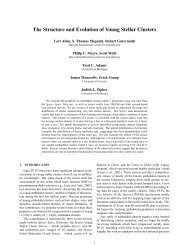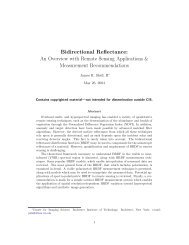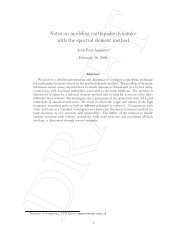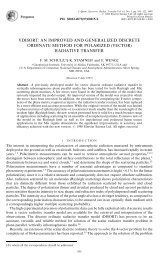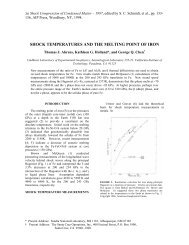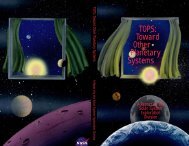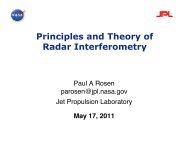squared parameter, so that Jacobians for the wind speed can also be determined for this case. It ispossible to calculate higher order contributions, so that R ( Ω,Ω0) = ∑ R Ω Ωs s( ,0) for scatteringorder s, but this is a time-consuming process. For more details see [Jin et al., 2006].In general, one extra order of scattering enhances the BRDFs by 5-15%, depending on thegeometrical configuration; second and higher order contributions are generally at the 1% level orless. We have found that the neglect of multiple glitter reflectances can lead to errors of 1-3% inthe upwelling intensity at the top of the atmosphere, the higher figures being for larger solarzenith angles.In Versions 2.4 and 2.5 of <strong>VLIDORT</strong>, this multiple-reflected glitter was confined to the directbeam calculation for one extra order of scattering. In version 2.6 of <strong>VLIDORT</strong>, we havedeveloped a facility for computing multiply-reflected glitter for any order of scattering,applicable to the direct beam BRDF computation as well as the four Fourier component terms.6.3.5. Scalar land surface BRDF kernels<strong>VLIDORT</strong> has an implementation of a set of 5 semi-empirical MODIS-type kernels applicable tovegetation canopy [Wanner et al., 1995]; each such kernel must be used in a linear combinationwith a Lambertian kernel. Thus, for example, a Ross-thin BRDF surface type requires acombination of a Ross-thin kernel and a Lambertian kernel:ρtotal( θ , α,φ)= c1 ρRossthin( θ , α,φ)+ c2(6.3.12)Linear factors c 1 and c 2 are interdependent, and are specified in terms of basic quantities of thevegetation canopy. The kernels divide into two groups: those based on volume scatteringempirical models of light reflectance (Ross-thin, Ross-thick), and those based on geometricopticsmodeling (Li-sparse, Li-dense, Roujean). See [Wanner et al., 1995] and [Spurr, 2004] fordetails of the kernel formulae.<strong>VLIDORT</strong> also has implementations of two other semi-empirical kernels for vegetation cover;these are the Rahman [Rahman et al., 1993] and Hapke [Hapke, 1993] BRDF models. Bothkernels have three nonlinear parameters, and both contain parameterizations of the backscatterhot-spot effect. Here is the Hapke formula:ρhapkeω( μi, μj, φ)=8( μ + μ )⎪⎧⎛ Bh ⎞⎨⎜1+⎟⎪⎩ ⎝ h + tanα⎠i( 2 + cosΘ)j+(1 + 2μ⎪⎫i)(1 + 2μj)−1( )( ) ⎬1+2μ1−ω 1+2μ1−ω ⎪ ⎭ij. (6.3.13)In this equation, the three nonlinear parameters are the single scattering albedo ω, the hotspotamplitude h and the empirical factor B; μ i and μ j are the directional cosines, and Θ is thescattering angle, with α = ½Θ.The important point to note here is that all these kernels are fully differentiable with respect toany of the non-linear parameters defining them. For details of the kernel derivatives, see [Spurr,2004]. It is thus possible to generate analytic weighting functions for a wide range of surfaces in114
the models. Surface reflectance Jacobians have also been considered in other linearized RTmodels [Hasekamp and Landgraf, 2002; Ustinov, 2005].These kernels were developed for scalar BRDFs – the (1,1) component of the polarized surfacereflectance matrix. All scalar BRDFs have been implemented as part of the <strong>VLIDORT</strong> package.Polarized BRDFs over land surfaces are harder to come by. Here we report briefly on some newsemi-empirical formulae for BPDFs (Bidirectional Polarized Distribution Functions) [Maignan etal., 2009]. These BPDF kernels were supplied by F.-M. Bréon, and permission has been grantedto use them in <strong>VLIDORT</strong>, provided the work is properly acknowledged using the above 2009reference. See also section 3.2.4.6.3.6. Polarized land surface BRDF kernelsIn general, BPDFs are “spectrally neutral”, and modeling using specular reflection has becomethe accepted way of generating these functions. An empirical model was developed in part fromspecular reflection and in part from an analysis of POLDER measurements [Nada and Bréon,1999]. Recently, a great deal more BPDF information has been gleaned from data analysis ofseveral years of measurements from the PARASOL instrument. Based on this analysis, the paperof [Maignan et al., 2009] gives the following empirical formula for the BPDF:C exp[ − tanγ]exp[ −NDVI]Fp(γ , n)Rp(ΩS, ΩV) =; (6.3.14)μ + μSVHere, Ω S and Ω V are the incident and reflected geometries for nadir angles μ S and μ V , γ is half thephase angle of reflectance, n the refractive index of the vegetative matter (taken to be 1.5), C is aconstant, and Fp is the Fresnel reflectance matrix. Calculation of Fp follows the specificationgiven above for the Cox-Munk BRDF. The only parameter is the Vegetation Index NDVI, whichvaries from -1 to 1 and is defined as the ratio of the difference to the sum of two radiancemeasurements, one in the visible and one in the infrared.6.3.7. The direct beam correction for BRDFsFor BRDF surfaces, the reflected radiation field is a sum of diffuse and direct (“single-bounce”)components for each Fourier term. One can compute the direct reflected beam with the totalBRDF configured for the solar and line-of-sight directions, rather than use the truncated formsbased on Fourier series expansions. This exact “direct beam (DB) correction” is done before thediffuse field calculation in <strong>VLIDORT</strong>. Exact upwelling reflection (assuming plane-parallel beamattenuation) to optical depth τ may be written:↑⎡−τ⎤atmos⎡−( τatmos−τ) ⎤IREX( μ,φ,τ ) = I0ρtotal( μ,μ0,φ − φ0)exp⎢⎥ exp⎢⎥ . (6.3.15)⎣ μ0⎦ ⎣ μ ⎦For surface property Jacobians, we require computation of the derivatives of this DB correctionwith respect to the kernel amplitudes and parameters; this follows the discussion in section 2.5.1.For atmospheric profile weighting functions, the solar beam and line-of-sight transmittances inEq. (6.3.15) need to be differentiated with respect to layer variables.115
- Page 1:
User’s GuideVLIDORTVersion 2.6Rob
- Page 5 and 6:
Table of Contents1H1. Introduction
- Page 7 and 8:
1. Introduction to VLIDORT1.1. Hist
- Page 9 and 10:
Table 1.1 Major features of LIDORT
- Page 11 and 12:
In 2006, R. Spurr was invited to co
- Page 13:
corrections, and sphericity correct
- Page 16 and 17:
Matrix Π relates scattering and in
- Page 18 and 19:
m⎛ P⎞l( μ)0 0 0⎜⎟mmm ⎜ 0
- Page 20 and 21:
In the following sections, we suppr
- Page 22 and 23:
of the single scatter albedo ω and
- Page 24 and 25:
Here T n−1 is the solar beam tran
- Page 26 and 27:
~ + ~ ~ (1)~ ~ + ~ ~ (2)~ ~ − ~ 1
- Page 28 and 29:
The solution proceeds first by the
- Page 30 and 31:
Linearizations. Derivatives of all
- Page 32 and 33:
For the plane-parallel case, we hav
- Page 34 and 35:
One of the features of the above ou
- Page 36 and 37:
L↑↑ ↑k (cot n −cotn −1)[
- Page 38 and 39:
Note the use of the profile-column
- Page 40 and 41:
βl,aer(1)(2)fz1e1βl+ ( 1−f ) z2
- Page 42 and 43:
For BRDF input, it is necessary for
- Page 44 and 45:
streams were used in the half space
- Page 46 and 47:
anded tri-diagonal matrix A contain
- Page 48 and 49:
in place to aid with the LU-decompo
- Page 50 and 51:
In earlier versions of LIDORT and V
- Page 53 and 54:
4. The VLIDORT 2.6 package4.1. Over
- Page 55 and 56:
(discrete ordinates), so that dimen
- Page 57 and 58:
Table 4.2 Summary of VLIDORT I/O Ty
- Page 59 and 60:
Table 4.3. Module files in VLIDORT
- Page 61 and 62:
Finally, modules vlidort_ls_correct
- Page 63 and 64: end program main_VLIDORT4.3.2. Conf
- Page 65 and 66: $(VLID_DEF_PATH)/vlidort_sup_brdf_d
- Page 67 and 68: Finally, the command to build the d
- Page 69 and 70: Here, “s” indicates you want to
- Page 71 and 72: The main difference between “vlid
- Page 73 and 74: to both VLIDORT and the given VSLEA
- Page 75 and 76: STATUS_INPUTREAD is equal to 4 (VLI
- Page 77 and 78: 5. ReferencesAnderson, E., Z. Bai,
- Page 79 and 80: Mishchenko, M.I., and L.D. Travis,
- Page 81: Stamnes K., S-C. Tsay, W. Wiscombe,
- Page 84 and 85: Table A2: Type Structure VLIDORT_Fi
- Page 86 and 87: DO_WRITE_FOURIER Logical (I) Flag f
- Page 88 and 89: USER_LEVELS (o) Real*8 (IO) Array o
- Page 90 and 91: angle s, Stokes parameter S, and di
- Page 92 and 93: DO_SLEAVE_WFS Logical (IO) Flag for
- Page 94 and 95: 6.1.1.8. VLIDORT linearized outputs
- Page 96 and 97: NFINELAYERS Integer Number of fine
- Page 98 and 99: 6.1.2.4. VLIDORT linearized modifie
- Page 100 and 101: The output file contains (for all 3
- Page 102 and 103: The first call is the baseline calc
- Page 104 and 105: for a 2-parameter Gamma-function si
- Page 106 and 107: Remark. In VLIDORT, the BRDF is a 4
- Page 108 and 109: 6.3.3.1. Input and output type stru
- Page 110 and 111: Table C: Type Structure VBRDF_LinSu
- Page 112 and 113: Special note regarding Cox-Munk typ
- Page 116 and 117: 6.4. SLEAVE SupplementHere, the sur
- Page 118 and 119: is possible to define Jacobians wit
- Page 120 and 121: etween 0 and 90 degrees.N_USER_OBSG
- Page 122: 6.4.4.2 SLEAVE configuration file c



